Section 1: Agency overview and resources
1.1 Strategic direction
There has been no significant change to the strategic direction of the Department of the Treasury (the Treasury) from that outlined in the Portfolio Budget Statements 2013-14 (pages 15-17).
As a result of Administrative Arrangements Orders following the 2013 election, the small business policy function transferred to the Treasury from the Department of Industry.
The Treasury is seeking an additional $7.5 million in departmental funding through Appropriation Bill (No. 3) 2013-14. This comprises an additional $11.2 million which is offset by savings of $3.7 million.
The additional $11.2 million relates to:
- $0.5 million for the Foreign Ownership Register for Agricultural Land — establishment measure as outlined in the Economic Statement 2013;
- $1.8 million for the Super Council — funding measure as outlined in the Economic Statement 2013;
- $3.6 million for the Financial System Inquiry measure as outlined in the Mid-Year Economic and Fiscal Outlook 2013-14;
- $1.0 million for the Review of competition laws and policy measure as outlined in the Mid-Year Economic and Fiscal Outlook 2013-14; and
- $4.2 million for the transfer of the small business policy function to the Treasury from the Department of Industry.
The savings of $3.7 million relates to:
- $0.05 million for the Public Services efficiencies measure as outlined in Budget Paper No. 2, Budget Measures 2013-14;
- $0.2 million for Reforms to APS management and efficient procurement of agency software measure as outlined in the Economic Statement 2013;
- $1.5 million for Repeal of the Carbon Tax — abolishing energy market compensation measure as outlined in the Mid-Year Economic and Fiscal Outlook 2013-14;
- $1.8 million for Restoring integrity in the Australian tax system measure as outlined in the Mid-Year Economic and Fiscal Outlook 2013-14; and
- $0.2 million for Foreign Aid Reprioritisation that was agreed after the Mid-Year Economic and Fiscal Outlook 2013-14.
The Treasury is also seeking an additional $1.8 million in departmental equity injections through Appropriation Bill (No. 4) 2013-14 relating to:
- $0.2 million for the Financial System Inquiry measure as outlined in the Mid-Year Economic and Fiscal Outlook 2013-14; and
- $1.6 million for the transfer of the small business policy function to the Treasury from the Department of Industry.
The Treasury is seeking an additional $8.8 billion in administered items through Appropriation Bill (No. 3) 2013-14. This comprises an additional $8.8 billion which is offset by savings of $3.0 million.
The additional $8.8 billion relates to:
- $1.0 million for the Priority consumer focused superannuation activities measure as outlined in the Pre-Election Economic and Fiscal Outlook 2013;
- $8.8 billion for Strengthening the Reserve Bank Reserve Fund as outlined in the Mid-Year Economic and Fiscal Outlook 2013-14; and
- $1.1 million for the transfer of the small business policy function to the Treasury from the Department of Industry.
The savings of $3.0 million relates to:
- $2.0 million for the Superannuation Consumer Centre — savings measure as outlined in the Pre-Election Economic and Fiscal Outlook 2013; and
- $1.0 million for the Priority consumer focused superannuation activities measure as outlined in the Mid-Year Economic and Fiscal Outlook 2013-14.
The Treasury is also seeking an additional $18,000 in administered items through Appropriation Bill (No. 4) 2013-14. This relates to the transfer of the small business policy function to the Treasury from the Department of Industry.
1.2 Agency resource statement
Table 1.1 shows the total resourcing available from all sources for the 2013-14 Budget year, including variations through Appropriation Bills No. 3 and No. 4, special appropriations and special accounts.
Table 1.1: Department of the Treasury resource statement — additional estimates for 2013-14 as at Additional Estimates February 2014
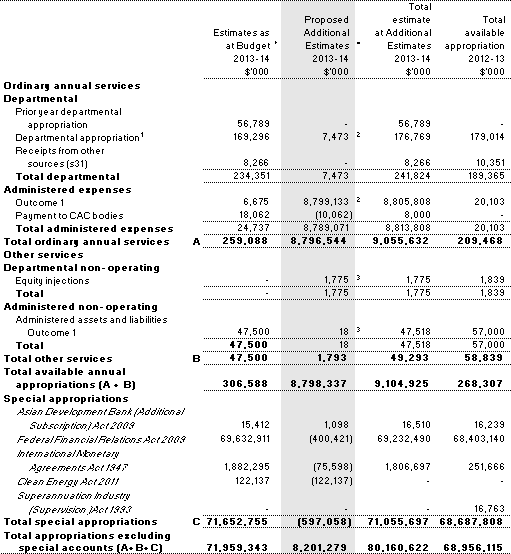
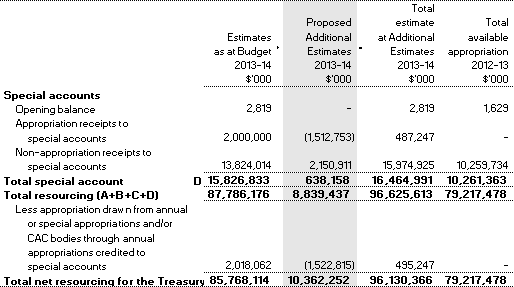
1 Includes $5.3 million in 2013-14 for the departmental capital budget (also refer to Table 3.2.5).
2 Appropriation Bill (No. 3) 2013-14.
3 Appropriation Bill (No. 4) 2013-14.
1.3 Agency measures table
Table 1.2 summarises new Government measures taken since the 2013-14 Budget.
Table 1.2: Agency Measures since Budget
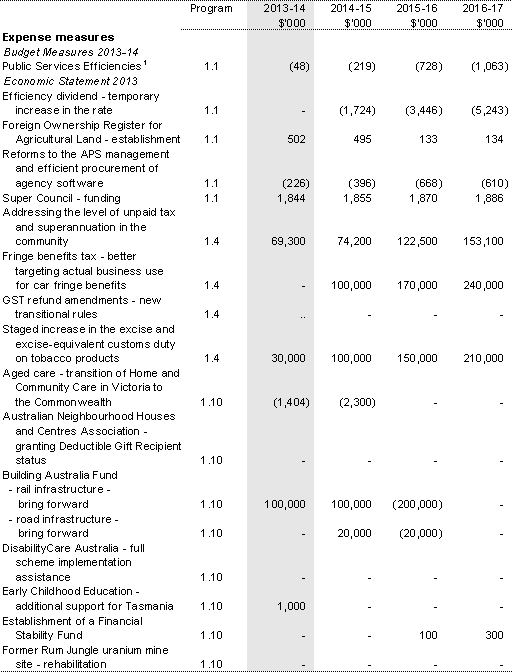
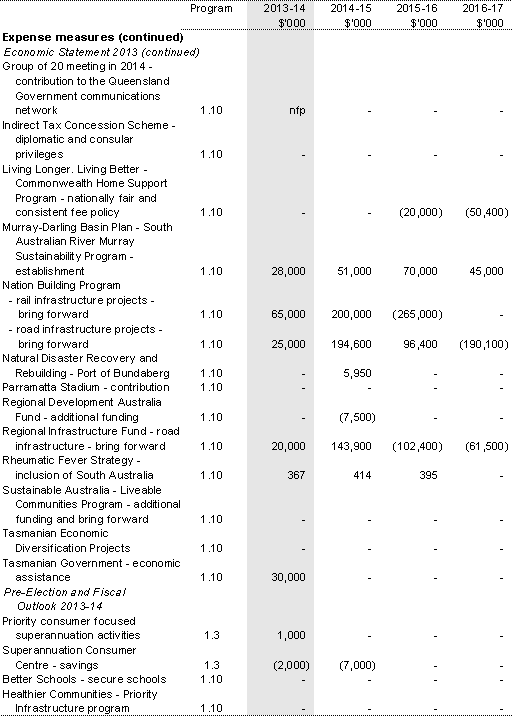
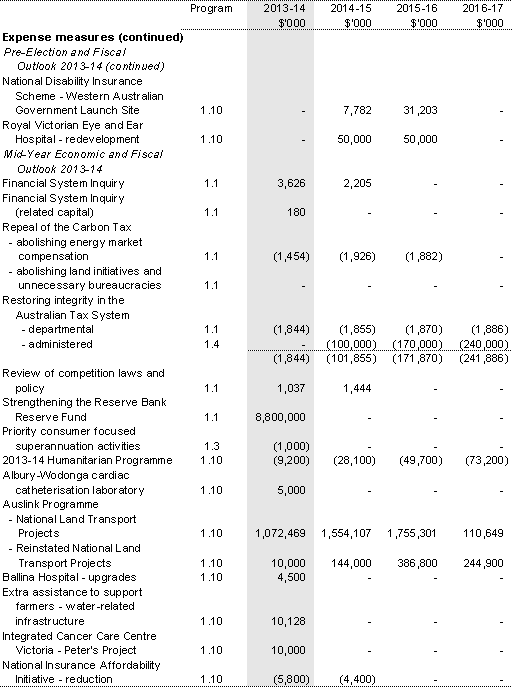
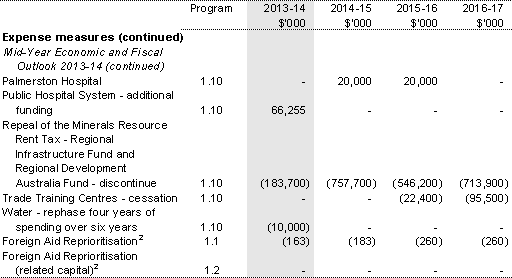
1 This measure was announced in the 2013-14 Budget as a cross portfolio measure and has not previously appeared in a portfolio statement.
2 This was agreed after the Mid-Year Economic and Fiscal Outlook 2013-14.
1.4 Additional estimates and variations
Table 1.3 details the additional estimates resulting from new measures since the 2013-14 Budget. Table 1.4 details the additional estimates resulting from other variations since the 2013-14 Budget.
Table 1.3: Additional estimates and variations to outcomes from measures since 2013-14 Budget
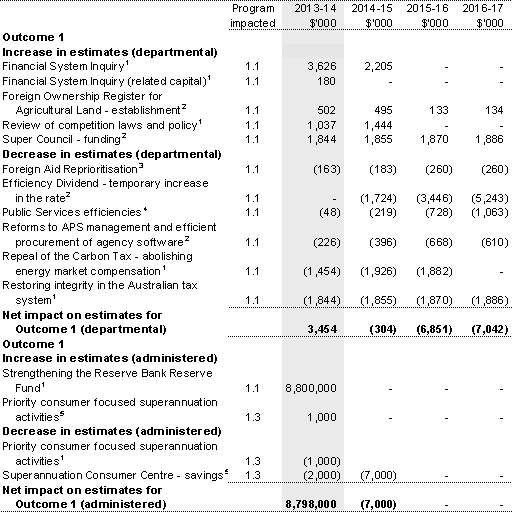
1 This measure was included in the Mid-Year Economic and Fiscal Outlook 2013-14.
2 This measure was included in the Economic Statement 2013.
3 This was agreed after the Mid-Year Economic and Fiscal Outlook 2013-14.
4 This measure was included in Budget Paper No. 2, Budget Measures 2013-14.
5 This measure was included in the Pre-Election Economic and Fiscal Outlook 2013.
Table 1.4: Additional estimates and variations to outcomes from other variations
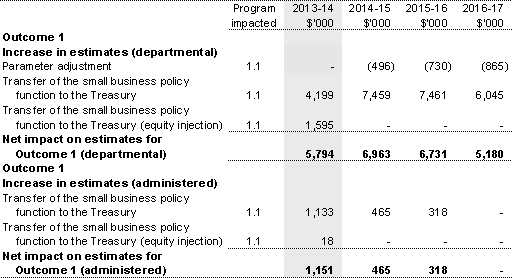
1.5 Breakdown of additional estimates by Appropriation Bill
The following table details the additional estimates sought for the Treasury through Appropriation Bills No. 3 and No. 4.
Table 1.5: Appropriation Bill (No. 3) 2013-14
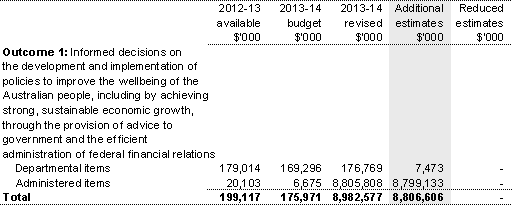
Table 1.6: Appropriation Bill (No. 4) 2013-14

Section 2: Revisions to agency outcomes and planned performance
2.1 Resources and performance information
There has been no change to outcomes or the outcome strategy for the Treasury from that included in the Portfolio Budget Statements 2013-14 (pages 24-25).
There has been no significant change to the program objective, expenses, deliverables or key performance indicators for program 1.2 and programs 1.4 to 1.10 that affect Appropriation Bills No. 3 and No. 4.
Programs 1.4 to 1.10 relate to Australia's Federal Relations. Further details of Australia's Federal Relations are on pages 65 to 75 of the Mid-Year Economic and Fiscal Outlook 2013-14.
Table 2.1: Budgeted expenses and resources for Outcome 1
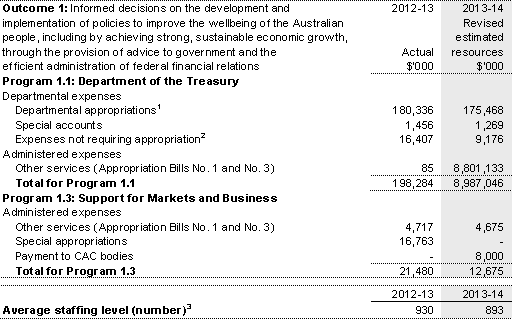
1 Departmental appropriations combine ordinary annual services (Appropriation Bills No. 1 and No. 3) and revenue from independent sources (section 31 receipts).
2 Expenses not requiring appropriation includes depreciation and amortisation expenses and resources received free of charge, such as audit fees.
3 The average staffing level for 2013-14 includes the transfer of the small business policy function to the Treasury from the Department of Industry offset by the Treasury offering voluntary redundancies.
Program 1.1: Department of the Treasury
There has been no significant change to the program objective, deliverables or key performance indicators from that included in the Portfolio Budget Statements 2013-14.
As a result of Administrative Arrangements Orders following the 2013 election, the small business policy function transferred to the Treasury from the Department of Industry. The Treasury now has responsibility for small business policy and supporting the activities of the Australian Small Business Commissioner.
The Treasury will provide a one-off $8.8 billion grant to the Reserve Bank of Australia (RBA) to meet its request to strengthen its financial position to the level considered appropriate by the RBA Board. The grant will ensure that the RBS is adequately resourced to conduct its monetary policy and foreign exchange operations in an environment of financial market volatility. This was outlined in the Mid-Year Economic and Fiscal Outlook 2013-14.
Program Expenses
Program expenses for the small business policy function are included in departmental items and administered expenses.
Table 2.2: Program 1.1 expenses
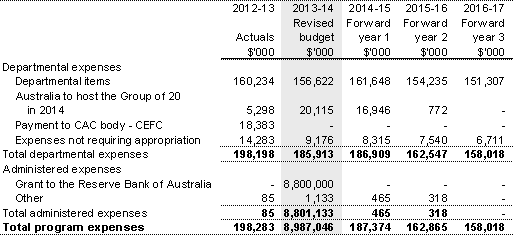
Program 1.3: Support for Markets and Business
There has been no significant change to the program objective, deliverables or key performance indicators from that included in the Portfolio Budget Statements 2013-14.
The Superannuation Consumer Centre will no longer proceed as outlined in the measure in the Pre-Election and Fiscal Outlook 2013-14.
Table 2.2: Program 1.3 expenses
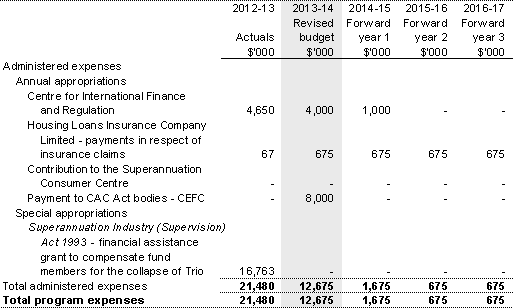
Section 3: Explanatory tables and budgeted financial statements
3.1 Explanatory tables
3.1.1 Estimates of special account flows
Special accounts provide a means to set aside and record amounts used for specific purposes. Table 3.1.1 shows the expected additions (receipts) and reductions (payments) for each account used by the Treasury.
Table 3.1.1: Estimates of special account cash flows and balances
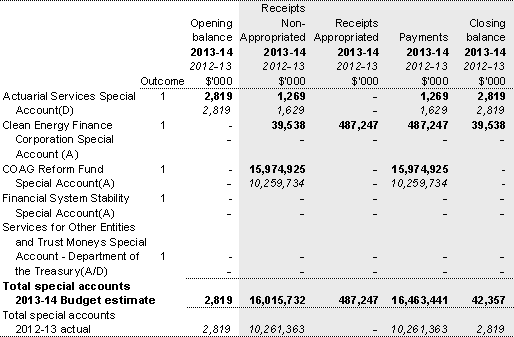
(A) Administered.
(D) Departmental.
3.2 Budgeted financial statements
3.2.1 Analysis of budgeted financial statements
The Department of the Treasury is budgeting for a departmental breakeven operating result for 2013-14.
The Department of the Treasury has a sound financial position and currently has sufficient cash reserves to fund provisions and payables, and asset replacement, as they fall due.
3.2.2 Budgeted financial statements
Table 3.2.1: Budgeted departmental comprehensive income statement
(for the period ended 30 June)
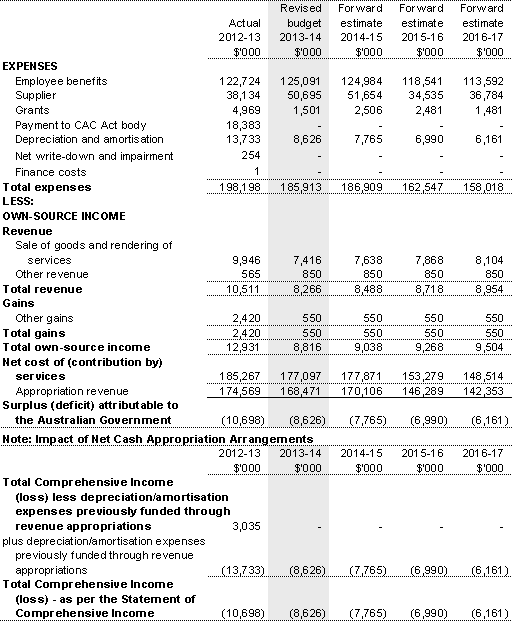
Prepared on Australian Accounting Standards basis.
Table 3.2.2: Budgeted departmental balance sheet
(as at 30 June)
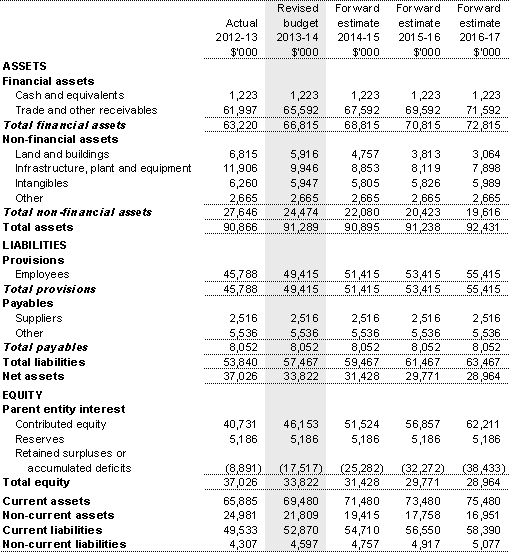
Prepared on Australian Accounting Standards basis.
Table 3.2.3: Budgeted departmental statement of cash flows
(for the period ended 30 June)
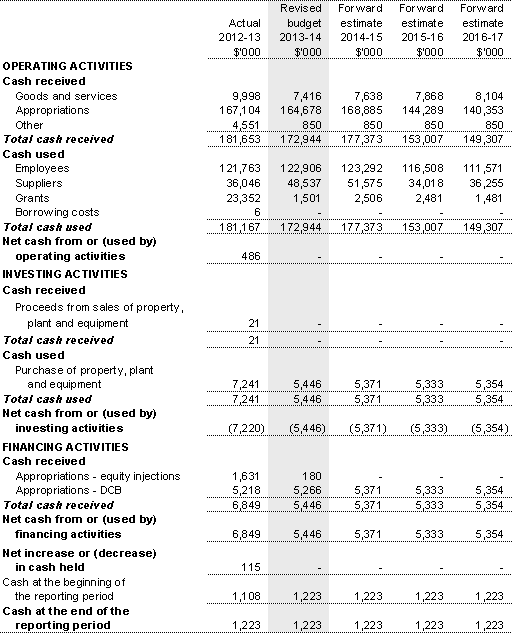
Prepared on Australian Accounting Standards basis.
Table 3.2.4: Departmental statement of changes in equity — summary of movement
(budget year 2013-14)
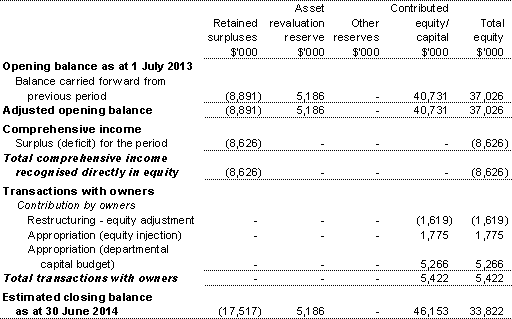
Prepared on Australian Accounting Standards basis.
Table 3.2.5: Departmental capital budget statement
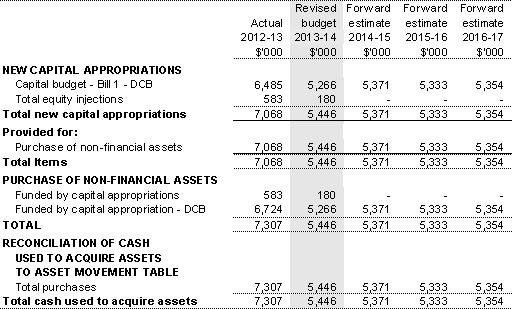
Prepared on Australian Accounting Standards basis.
Table 3.2.6: Statement of asset movements — Departmental (2013-14)

Prepared on Australian Accounting Standards basis.
Table 3.2.7: Schedule of budgeted income and expenses administered on behalf of Government
(for the period ended 30 June)
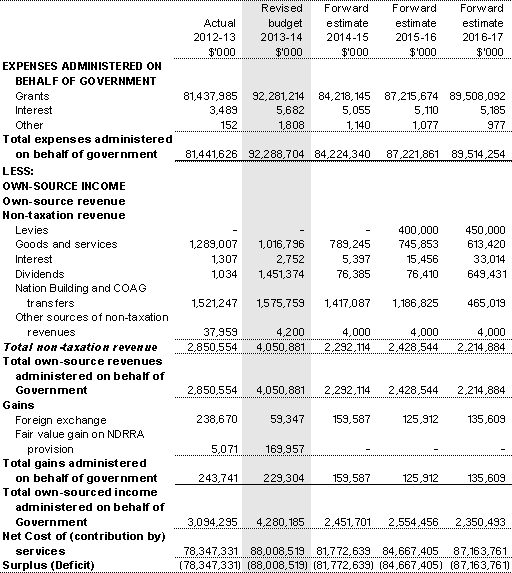
Prepared on Australian Accounting Standards basis.
Table 3.2.8: Schedule of budgeted assets and liabilities administered on behalf of Government
(as at 30 June)
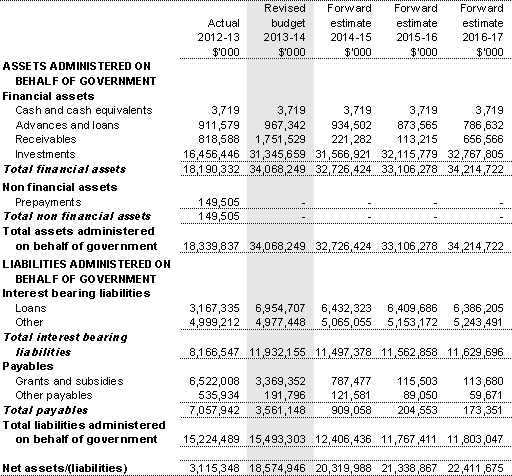
Prepared on Australian Accounting Standards basis.
Table 3.2.9: Schedule of budgeted administered cash flows
(for the period ended 30 June)

Prepared on Australian Accounting Standards basis.
Table 3.2.10: Schedule of Administered Capital Budget
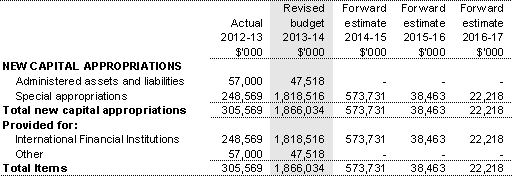
Prepared on Australian Accounting Standards basis.
Notes to the financial statements
The Treasury's budgeted statements are prepared on an accrual basis in accordance with:
- the Government's financial budgeting and reporting framework; and
- Australian Accounting Standards and Interpretations issued by the Australian Accounting Standards Board.
Under the Government's accrual budgeting framework, and consistent with Australian Accounting Standards, transactions that departments control (departmental transactions) are separately budgeted for, and reported on, from transactions departments do not have control over (administered transactions). This ensures that departments are only held accountable for the transactions over which they have control.
Departmental assets, liabilities, revenues and expenses are controlled by the department. Departmental expenses include employee and supplier expenses and other administrative costs, which are incurred by the department in providing goods and services.
Administered items are revenues, expenses, assets or liabilities which are managed by the department on behalf of the Government according to set government directions. Administered expenses include subsidies, grants and personal benefit payments, and administered revenues include taxes, fines and excises.